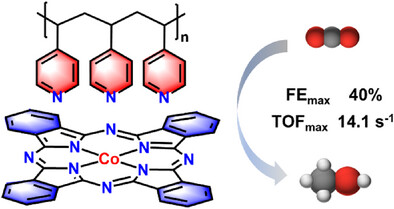Strengthening Intermediate Adsorption on a Cobalt Phthalocyanine Assembly by Polymeric Modification for Electrochemical Carbon Dioxide Reduction into Methanol
Poe Ei Phyu Win1, Xin Xu1, Lilong Zhang2, Song Yang2(杨松)*, Shibin Ren3, Yu Chen4(陈煜)*, Jiong Wang1(王炯)*
1Innovation Center for Chemical Science, Jiangsu Key Laboratory of Advanced Negative Carbon Technologies, College of Chemistry,Chemical Engineering and Materials Science, Soochow University,Suzhou 215123, P.R. China
2National Key Laboratory of Green Pesticide, Key Laboratory of Green Pesticide and Agricultural Bioengineering, Ministry of Education, State-Local Joint Laboratory for Comprehensive Utilization of Biomass, Center for R&D of Fine Chemicals, Guizhou University, Guiyang 550025, P.R. China
3Department of Chemistry, School of Pharmaceutical and ChemicalEngineering, Taizhou University, Taizhou 318000, P.R. China
4School of Materials Science and Engineering, Shaanxi NormalUniversity, Xi’an 710062, P.R. China
Angew. Chem. Int. Ed. 2025, 64, e202517033
Abstract: Electrochemical carbon dioxide reduction (CO2R) to generate value added methanol (MeOH) in water has been considered as a potential strategy to realize efficient carbon cycle and reutilization. Cobalt phthalocyanine (CoPc) represents as a classical molecular catalyst carrying precisely tunable active sites, which has been widely explored for the CO2-to-MeOH conversion, but optimization of performance is suffering from relatively easiness in desorption of *CO intermediate. To this end, we developed a novel molecular assembly of CoPc nanotubes (CoT) driven by van der Waals force with surface being modified by poly(4-vinylpyridine). The as-derived catalyst exhibited an exceptional performance of MeOH production for the turnover frequency enhanced by more than 14-fold compared to the pristine CoT, and the Faradaic efficiency is up to 40% at a moderate potential. It revealed that the pyridyl groups of P4VP axially coordinated with the Co catalytic centers shifted the d-band center toward the Fermi level, which strengthened the chemisorption and activation of *CO intermediates, thereby decreasing the whole barrier to produce MeOH. This work demonstrates a novel insight into intermediate manipulation of CO2R and highlights the potential of molecular electrocatalysis for carbon valorization.

Article information: https://doi.org/10.1002/anie.202517033